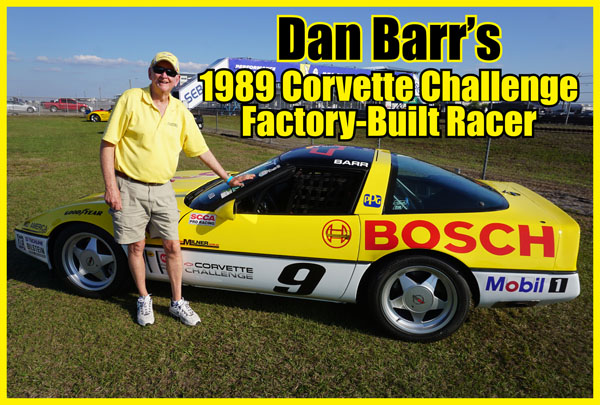A Look Back at the First-Ever Factory-Built Customer Spec Race Cars
Get Into the Time Machine Inside Your Head
Imagine for just a little while that it’s 1988-1989 and you know nothing about Z06 Corvettes, supercharged Corvettes, or mid-engine Corvettes, and the Corvette ZR-1 “King of the Hill” super-Vette is just over the horizon.
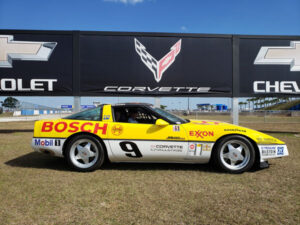 The times were very good for Corvette and the new C4. With massive tires and modern suspension, the C4 could go around corners like never before. In 1985 electronic-controlled fuel injection was back and Car and Driver proclaimed the Corvette, “The Fastest Car In America”, clocking at 150 mph! Starting in 1985, Corvettes became the new “Untouchables” and started a three-year total domination in SCCA’s Showroom Stock racing.
The times were very good for Corvette and the new C4. With massive tires and modern suspension, the C4 could go around corners like never before. In 1985 electronic-controlled fuel injection was back and Car and Driver proclaimed the Corvette, “The Fastest Car In America”, clocking at 150 mph! Starting in 1985, Corvettes became the new “Untouchables” and started a three-year total domination in SCCA’s Showroom Stock racing.
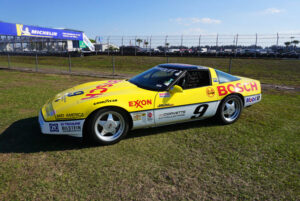 The competition was so flummoxed, Porsche bought a C4 to take apart to see why the car was so damn fast. Corvette fans enjoyed seeing Porsche eat some Humble Pie. Of course, the situation couldn’t run on too long. Rather than tell the other sports car manufacturers, to build a better car, Corvette was kicked out of the Showroom Stock Series. Yes, kicked out for being too fast! This is an amazing thing to consider because early C4s are the cheapest, least respected Corvettes around. Fans loved the Showroom Stock Series because they knew, “I own one of those too!”.
The competition was so flummoxed, Porsche bought a C4 to take apart to see why the car was so damn fast. Corvette fans enjoyed seeing Porsche eat some Humble Pie. Of course, the situation couldn’t run on too long. Rather than tell the other sports car manufacturers, to build a better car, Corvette was kicked out of the Showroom Stock Series. Yes, kicked out for being too fast! This is an amazing thing to consider because early C4s are the cheapest, least respected Corvettes around. Fans loved the Showroom Stock Series because they knew, “I own one of those too!”.
But the Party Wasn’t Over
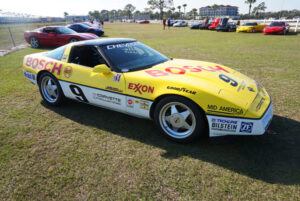 Corvette performance was back and race promoter John Powel, from Toronto, Canada wasn’t about to tuck tail and complain. Powel pitched Chevrolet the idea of a million-dollar, ten-race series with equally-prepared Corvettes. Chevrolet was warm to the idea, as they were heavily involved in NASCAR, the Callaway B2K Twin-Turbo was an official Corvette option, and the all-aluminum, double-overhead-cam (DOHC) ZR-1 was in the works.
Corvette performance was back and race promoter John Powel, from Toronto, Canada wasn’t about to tuck tail and complain. Powel pitched Chevrolet the idea of a million-dollar, ten-race series with equally-prepared Corvettes. Chevrolet was warm to the idea, as they were heavily involved in NASCAR, the Callaway B2K Twin-Turbo was an official Corvette option, and the all-aluminum, double-overhead-cam (DOHC) ZR-1 was in the works.
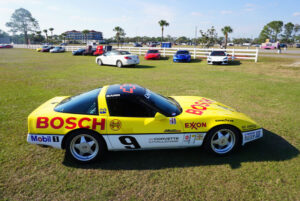 The new Corvette-only series was called, “The Corvette Challenge Series” and it came together quickly. The concept wasn’t new, as the International Race of Champions Series (IROC) had been around since 1974. IROC was launched with Porsche Carrera RSR cars that proved to be too expensive to build and maintain. From 1975 to 1989 it was an all-Camaro series.
The new Corvette-only series was called, “The Corvette Challenge Series” and it came together quickly. The concept wasn’t new, as the International Race of Champions Series (IROC) had been around since 1974. IROC was launched with Porsche Carrera RSR cars that proved to be too expensive to build and maintain. From 1975 to 1989 it was an all-Camaro series.
The 1988 Corvette Challenge Cars
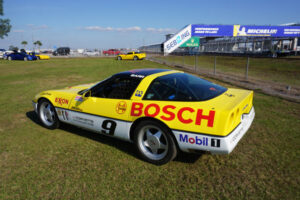 While the basic formula is the same as the IROC Camaros. The cars rolled off the Bowling Green assembly line as “RPO B9B” with the same options that included the following; the Z51 Performance Handling Package that included the new Bosch ABS II, larger-diameter stabilizer bars, Bilstein shocks, restyled 17×9.5-inch wheels with twelve cooling slots, shod with P275ZR17 Goodyear tires, higher-rate springs, a finned power steering cooler, larger 13.1”x1-1/6” front brake rotors and duel-piston calipers, the Doug Nash 4-3 manual transmission, 6-way power driver’s seat, a Delco-Bose stereo radio, Rear Window + Side Mirror Defogger, and removable blue-tinted roof panel. The 1988 Corvette base price was $29,489 and the additional options brought to total to around $33,500.
While the basic formula is the same as the IROC Camaros. The cars rolled off the Bowling Green assembly line as “RPO B9B” with the same options that included the following; the Z51 Performance Handling Package that included the new Bosch ABS II, larger-diameter stabilizer bars, Bilstein shocks, restyled 17×9.5-inch wheels with twelve cooling slots, shod with P275ZR17 Goodyear tires, higher-rate springs, a finned power steering cooler, larger 13.1”x1-1/6” front brake rotors and duel-piston calipers, the Doug Nash 4-3 manual transmission, 6-way power driver’s seat, a Delco-Bose stereo radio, Rear Window + Side Mirror Defogger, and removable blue-tinted roof panel. The 1988 Corvette base price was $29,489 and the additional options brought to total to around $33,500.
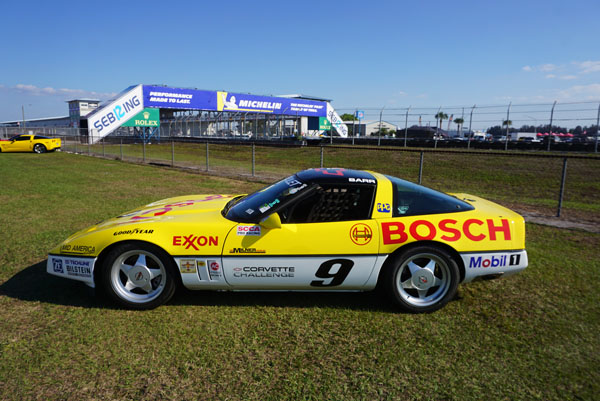 The L98 engines were specially-built at the Flint, Michigan plant and calibrated to equal horsepower levels, and sent to Bowling Green for assembly. Each engine’s bolts and screws were painted with special paint that could only be seen in low light with laser light to verify that the engine had not been tampered with. Fifty-six cars were built and forty-five of the cars were sent to Protofab, in Wixom, Michigan for preparation. “Protofab” later became Pratt & Miller.
The L98 engines were specially-built at the Flint, Michigan plant and calibrated to equal horsepower levels, and sent to Bowling Green for assembly. Each engine’s bolts and screws were painted with special paint that could only be seen in low light with laser light to verify that the engine had not been tampered with. Fifty-six cars were built and forty-five of the cars were sent to Protofab, in Wixom, Michigan for preparation. “Protofab” later became Pratt & Miller.
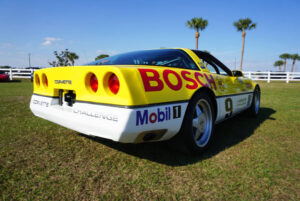 Each car received a roll cage, a racing seat, a safety harness, a fire suppression system, PBR racing brake pads and ducting, a low-restriction Desert Driveline exhaust, Dymag magnesium wheels with shaved-to-half-depth Goodyear tires, and special “Corvette Challenge” emblems. The Protofab preparation cost $15,000 for a grand total of $48,043. That’s just over $124,000 in 2023 dollars. Race cars have never been cheap.
Each car received a roll cage, a racing seat, a safety harness, a fire suppression system, PBR racing brake pads and ducting, a low-restriction Desert Driveline exhaust, Dymag magnesium wheels with shaved-to-half-depth Goodyear tires, and special “Corvette Challenge” emblems. The Protofab preparation cost $15,000 for a grand total of $48,043. That’s just over $124,000 in 2023 dollars. Race cars have never been cheap.
The 1989 Corvette Challenge Cars
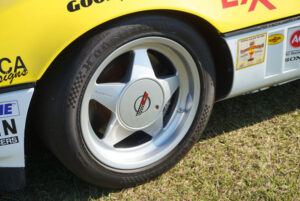 The 1989 Challenge cars used the same formula, but with a few changes. Sixty RPO R7F Challenge cars came off the Bowling Green assembly line with the same package as the 1988 cars, but with the new-and-improved ZF 6-speed transmission. Upon completion, twenty-nine Challenge cars were sent to Powell Development America for the same preparation as the 1988 cars but received straight-through exhaust that exited the side out the rear fenders and a roll cage with sidebars.
The 1989 Challenge cars used the same formula, but with a few changes. Sixty RPO R7F Challenge cars came off the Bowling Green assembly line with the same package as the 1988 cars, but with the new-and-improved ZF 6-speed transmission. Upon completion, twenty-nine Challenge cars were sent to Powell Development America for the same preparation as the 1988 cars but received straight-through exhaust that exited the side out the rear fenders and a roll cage with sidebars.
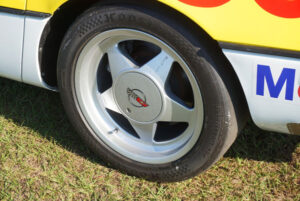 During the 1988 Series, there were complaints that some cars had more horsepower. To assure this was not happening, an electronic telemetry box was installed in place of the passenger-side airbag to monitor engine output. And to keep things fair, ten cars per race were monitored in random sequence.
During the 1988 Series, there were complaints that some cars had more horsepower. To assure this was not happening, an electronic telemetry box was installed in place of the passenger-side airbag to monitor engine output. And to keep things fair, ten cars per race were monitored in random sequence.
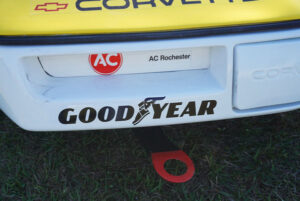 Unlike the 1988 Challenge cars that were built on the assembly line with certified, equally-built engines, they came off the line with the stock L98 engines. The stock, numbers-matching engines were crated and stored with Powell so that if the owner ever wanted to take his car back to “stock”, he could. Again, the L98 engines were assembled for identical power. According to Dan Barr, owner of the #9 Bosch Challenge Corvette, the power output was around 300 horsepower. While all Challenge cars were “purpose-built” race cars, they were all street-legal and carried the full factory warranty. The window sticker for Dan Barr’s Challenge Corvette totaled, $36,193. (around $89,500 in 2023 dollars)
Unlike the 1988 Challenge cars that were built on the assembly line with certified, equally-built engines, they came off the line with the stock L98 engines. The stock, numbers-matching engines were crated and stored with Powell so that if the owner ever wanted to take his car back to “stock”, he could. Again, the L98 engines were assembled for identical power. According to Dan Barr, owner of the #9 Bosch Challenge Corvette, the power output was around 300 horsepower. While all Challenge cars were “purpose-built” race cars, they were all street-legal and carried the full factory warranty. The window sticker for Dan Barr’s Challenge Corvette totaled, $36,193. (around $89,500 in 2023 dollars)
About the Races
 Corvette fans loved the series because the cars were close to the C4s they drove. The Series ran fifty-minute races at CART and IMSA big events and were covered on ESPN’s “Speed Vision” cable network with live-time telemetry. All of the cars used fuel from the same tanker vehicle to keep things even.
Corvette fans loved the series because the cars were close to the C4s they drove. The Series ran fifty-minute races at CART and IMSA big events and were covered on ESPN’s “Speed Vision” cable network with live-time telemetry. All of the cars used fuel from the same tanker vehicle to keep things even.
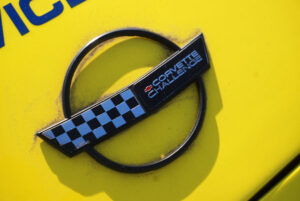 Because the races were short and the cars were equally prepared, the races were all about the driver’s and the pit crew’s skills. Consequently, the way to win was to drive very aggressively. Chevrolet sold lots of replacement body panels! The racing was exciting and the fans loved it. Even though it was Corvette-verses-Corvette, the Series won the day with great racing.
Because the races were short and the cars were equally prepared, the races were all about the driver’s and the pit crew’s skills. Consequently, the way to win was to drive very aggressively. Chevrolet sold lots of replacement body panels! The racing was exciting and the fans loved it. Even though it was Corvette-verses-Corvette, the Series won the day with great racing.
Series Winners and the Drivers
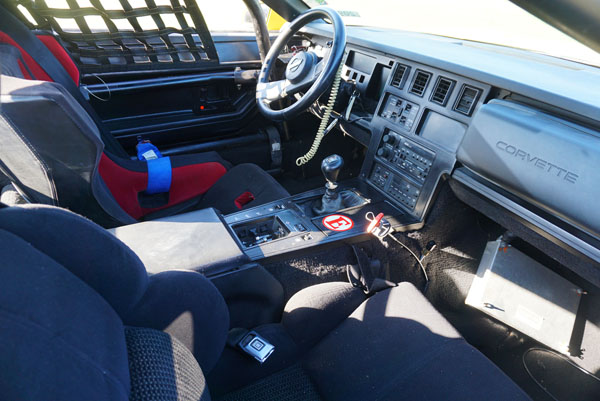 There was no shortage of enthusiasts and drivers that wanted in on the Corvette Challenge Series. After all, a turnkey Corvette race car for only $48,000? As race cars are concerned, they were very durable and dependable, as our friend Dan Barr can attest to.
There was no shortage of enthusiasts and drivers that wanted in on the Corvette Challenge Series. After all, a turnkey Corvette race car for only $48,000? As race cars are concerned, they were very durable and dependable, as our friend Dan Barr can attest to.
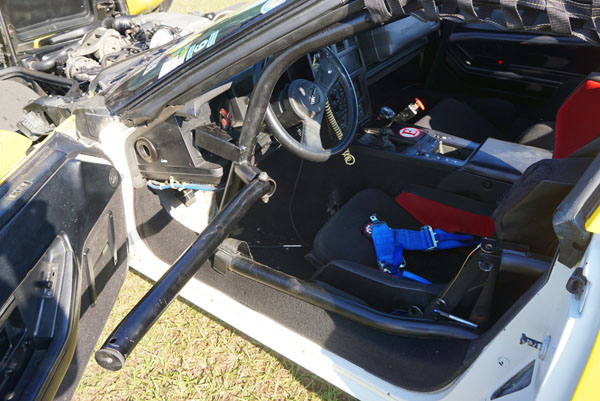 The 1988 Corvette Challenge Series had twenty-six cars and was won by Stu Hayner driving the Tom Bell Chevrolet/Auto Craft #36 Corvette. Several high-profile names drove the 1988 Challenge cars including; Andy Pilgrim (Andy joined the Corvette Racing Team in 1999, raced at Le Mans, and was co-driver with Dale Earnhardt at the 2001 24 Hours of Daytona), racing champion Juan Manuel Fango, three-time Indy 500 winner Johnny Rutherford, and Olympic Gold Medal winner Bruce Jenner,
The 1988 Corvette Challenge Series had twenty-six cars and was won by Stu Hayner driving the Tom Bell Chevrolet/Auto Craft #36 Corvette. Several high-profile names drove the 1988 Challenge cars including; Andy Pilgrim (Andy joined the Corvette Racing Team in 1999, raced at Le Mans, and was co-driver with Dale Earnhardt at the 2001 24 Hours of Daytona), racing champion Juan Manuel Fango, three-time Indy 500 winner Johnny Rutherford, and Olympic Gold Medal winner Bruce Jenner,
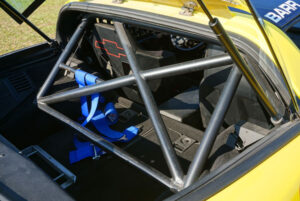 The 1989 Series wrapped up at the St. Petersburg race and was won by Bill Cooper driving the Rippie Racing #3 Corvette. High-profile drivers included; John Greenwood, Andy Pilgrim, and actor Bobby Carradine.
The 1989 Series wrapped up at the St. Petersburg race and was won by Bill Cooper driving the Rippie Racing #3 Corvette. High-profile drivers included; John Greenwood, Andy Pilgrim, and actor Bobby Carradine.
Corvette Challenge Series Comes to an End
The Corvette Challenge Series was supposed to be a zero-cost, sponsor-paid-for program for Chevrolet. But it ended up costing Chevrolet around a million dollars. However, it was money well-spent. It’s no secret that the factory-backed C5-R Racing Team launched in 1999 was Corvette Engineering’s defacto Z06 Corvette R&D division. The C6 Z06, C7 Z06, and the new C8 Z06 Corvettes all benefited from the previous generation race cars. The same thing happened in 1990 as the C4 entered its “Mid-Cycle Refresh” as field research from the Corvette Challenge race cars went into production Corvettes.
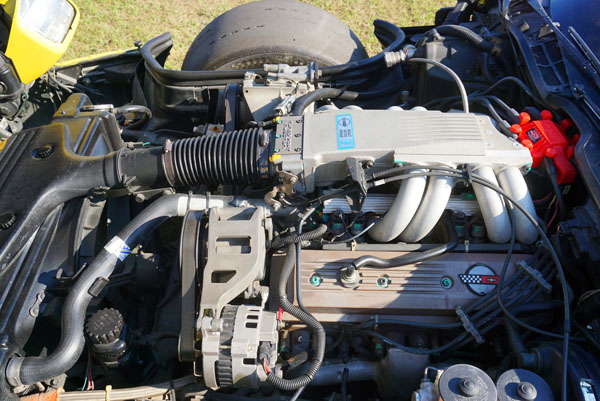 Meanwhile, SCCA was still thinking about its Showroom Stock Series experience. By 1990 competition manufacturers that complained about the Corvettes, felt that they had caught up. So, SCCA decided to let factory-built Corvette race cars enter their new World Challenge Series. Chevrolet offered RPO R9G Corvette race cars and built 23 cars. By the end of the season, Corvette won the series. Between 1985 and 1990, Showroom Stock Series, the Corvette Challenge Series, and the World Challenge Series, C4 L98-powered Corvettes proved their mettle among their sports car peers. It’s a chapter of the Corvette story that has been largely forgotten because future Corvettes were so good.
Meanwhile, SCCA was still thinking about its Showroom Stock Series experience. By 1990 competition manufacturers that complained about the Corvettes, felt that they had caught up. So, SCCA decided to let factory-built Corvette race cars enter their new World Challenge Series. Chevrolet offered RPO R9G Corvette race cars and built 23 cars. By the end of the season, Corvette won the series. Between 1985 and 1990, Showroom Stock Series, the Corvette Challenge Series, and the World Challenge Series, C4 L98-powered Corvettes proved their mettle among their sports car peers. It’s a chapter of the Corvette story that has been largely forgotten because future Corvettes were so good.
Corvette Challenge Cars Impounded!
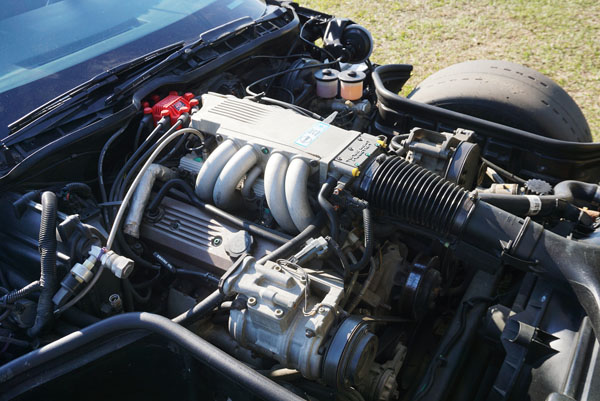 After the last Corvette Challenge Series in St. Petersburg, Florida, Chevrolet impounded the cars. It wasn’t as nefarious as it sounded. Chevrolet knew that team owners would sell their cars to recoup some of their expenses. The racing L98 engines were replaced with the stored original assembly line production engines. This way, the Corvette Challenge cars would have their numbers-matching engine. While the Challenge cars had “stock” engines, each engine was more perfectly built. The engines used in the ’89 cars were (unofficially) closer to around 300 horsepower.
After the last Corvette Challenge Series in St. Petersburg, Florida, Chevrolet impounded the cars. It wasn’t as nefarious as it sounded. Chevrolet knew that team owners would sell their cars to recoup some of their expenses. The racing L98 engines were replaced with the stored original assembly line production engines. This way, the Corvette Challenge cars would have their numbers-matching engine. While the Challenge cars had “stock” engines, each engine was more perfectly built. The engines used in the ’89 cars were (unofficially) closer to around 300 horsepower.
Chevrolet made lots of racing versions of the L98s so that if a car’s engine was damaged it could be replaced with a fresh, to-spec L98. Anyone that bought a Challenge car was given the opportunity to make a $4,000 “donation” for a race engine through the Chevy Race Shop.
Dan Barr Buys Goes Racing With a 1989 Corvette Challenge Car
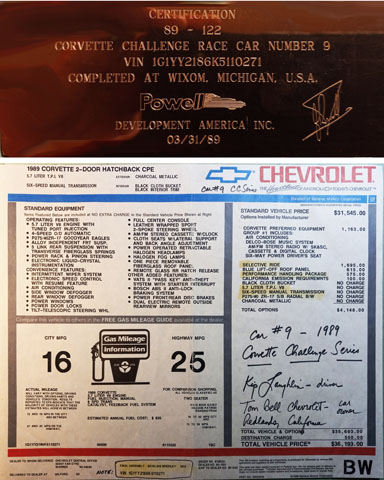 Dan Barr from Fort Lauderdale, Florida, has been a car guy since he can’t remember. Along his life’s journey, Dan has owned and enjoyed many Corvettes. Dan’s affection for Corvettes was centered on looks, performance, and power. When that’s your focus of attention, the notion, “… one of these days…” is always there.
Dan Barr from Fort Lauderdale, Florida, has been a car guy since he can’t remember. Along his life’s journey, Dan has owned and enjoyed many Corvettes. Dan’s affection for Corvettes was centered on looks, performance, and power. When that’s your focus of attention, the notion, “… one of these days…” is always there.
He recalls, “I was following the Corvette Challenge Series because I thought the cars were so cool. When I learned that the cars were For Sale, I jumped right on one!” Some of the original owners just wanted to unload the cars and offered them at very reasonable prices. Dan explains, “I was looking at another Challenge car when I found the #9 Bosch car for $10,000 less. The car had been refurbished at the Tom Milner Race Shop. The car looked absolutely brand new, so I gave the original owner and campaigner of the car, Kip Laughlin, a deposit. For $34,000 I had a turn-key race car!” Does that name sound familiar? Yes, that’s Corvette Racing Team driver, Tommy Milner’s dad. Tom had supported Kip’s car through the entire season.
Dan bought the car for a reason, and it wasn’t to collect it – he planned to race it! “I got two L98s from the Chevy Shop and made my “donation”. First I did some autocross races in Miami at the old Opa Locka airport runways. I drove the car from my home and back on the highway to these events and got a lot of surprised looks. Then I took the car to Palm Beach International Raceway (PBIR). Then I took the car to Sebring to go get my SCCA Driver’s License and later my National Competition License. Guess who was in my class? Mr. Corvettes at Carlisle, Chip Miller! He was such a great guy and we became good friends. Chip and Mike Yager (owner of Mid-America Motorworks) kind of cornered the market and bought up lots of Challenge cars and engines. But I had what I wanted and got the experience I coveted on how to race cars.”
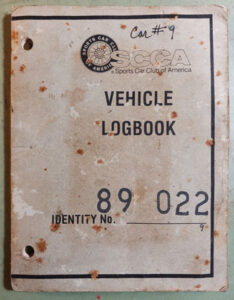 Dan started racing in 1990 and continued until the end of 1993. The car was very competitive and won a lot of regional events. Dan explains, “After a few years we got into a Camaro to race in the SCCA American Sedan Series that was a lot of fun. Then in 2005 I decided to get the Corvette Challenge car back out and ran in the 2005 HSR (Historic Sportscar Racing) event at Daytona. Going through the inner road course and then up on the wall at speed is really something to experience! Then in 2006 I was really going for it and entered the Challenge car in an HSR support race for the 12 Hours of Sebring race. That was another amazing experience!”
Dan started racing in 1990 and continued until the end of 1993. The car was very competitive and won a lot of regional events. Dan explains, “After a few years we got into a Camaro to race in the SCCA American Sedan Series that was a lot of fun. Then in 2005 I decided to get the Corvette Challenge car back out and ran in the 2005 HSR (Historic Sportscar Racing) event at Daytona. Going through the inner road course and then up on the wall at speed is really something to experience! Then in 2006 I was really going for it and entered the Challenge car in an HSR support race for the 12 Hours of Sebring race. That was another amazing experience!”
Remember, the Corvette Challenge Cars Are Street-legal!
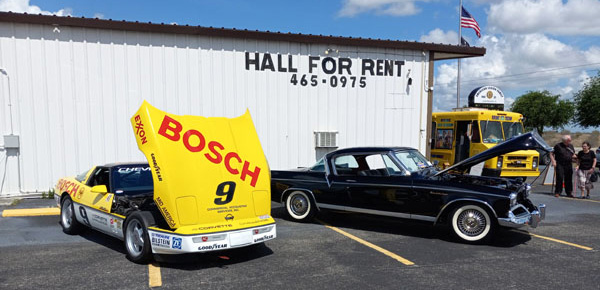
I asked Dan if he ever drives the car on the street. He laughed and shared this. “Well, yes. As the registered owner of the car, I got a recall notice telling me to take the car to my local Chevy Service Center to have some rear suspension parts replaced. I was leasing cars at the time, so I put a set of dealer tags on the car and drove it to Ed Morse Chevrolet in Kauderhill, Florida. The car has a straight exhaust, so it really loud, and with all the lettering on the car they looked at me kind of funny. The service writer said if the VIN number wasn’t blocked they’d take care of the recall. They identified the number, made the repair, and sent me on my way, at no charge!”
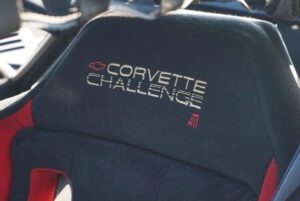 Despite a few treks on public roads, Dan’s Corvette Challenge car has never been anything but a race car. To date, the odometer shows just over 6,000 miles and an unknown number of hard turns. Dan explains, “This has been a great car. It’s fun to drive, handles great, it’s loud and has been a very dependable race car. The ZF 6-speed transmission is just about bulletproof. I’ve got all of the original paperwork and other memorabilia. I even have the original metal box that housed the telemetry unit and the original dash plaque installed by Powell Development America. And I’ve had it up to between 150-and-160-mph. Fast enough for me!”
Despite a few treks on public roads, Dan’s Corvette Challenge car has never been anything but a race car. To date, the odometer shows just over 6,000 miles and an unknown number of hard turns. Dan explains, “This has been a great car. It’s fun to drive, handles great, it’s loud and has been a very dependable race car. The ZF 6-speed transmission is just about bulletproof. I’ve got all of the original paperwork and other memorabilia. I even have the original metal box that housed the telemetry unit and the original dash plaque installed by Powell Development America. And I’ve had it up to between 150-and-160-mph. Fast enough for me!”
Dan’s Corvette Challenge Car Gets a Refresh
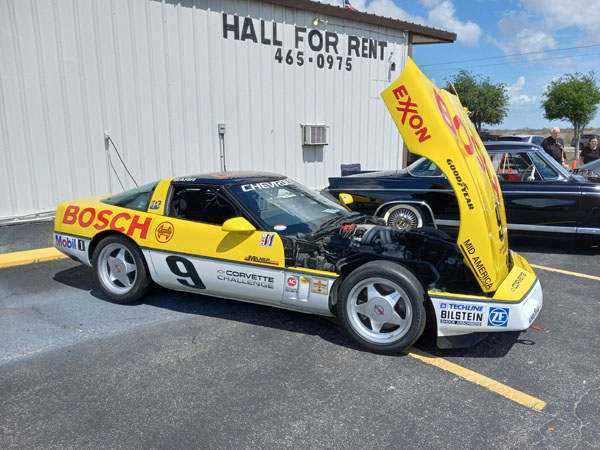
Race cars aren’t show cars and after many years the car was in need of a good refresh. Dan called on the help of his friend, George Haddad, owner of Fabulous Restorations, in Fort Lauderdale, Florida. George installed an SCCA-approved side hinge on the driver’s side of the roll cage to allow easier ingress and egress, and a new electronic ignition system. George repainted the front and rear bumper covers, refreshed to paint, repainted the Dymag wheels, and detailed the car, including new replacement decals. All of the fluids in Dan’s Challenge Corvette were changed and the L98 got a tune-up.
We mentioned that Dan has owned numerous Corvettes over the years. Parked in Dan’s garage have been a 1963 Split-Window Coupe, a 1984 Z51, a 1986 Pace Car, a 1991 Convertible, and a 1993 40th Anniversary Corvette. Dan estimates around 30 s in total all of which I wish I still had. In addition to the 1989 Corvette Challenge car, Dan currently has a 2004 LeMans Commemorative Edition Z06 (with the carbon fiber hood), a 2006 ZO6, a 2014 Velocity Yellow Z51 Coupe, and a 2020 Blade Silver C-8 Coupe. Early in 2020, Dan took delivery of a new C8 2020. In 2019 Dan’s car was part of the Corvettes at Carlisle Corvette Challenge 30th Anniversary event.
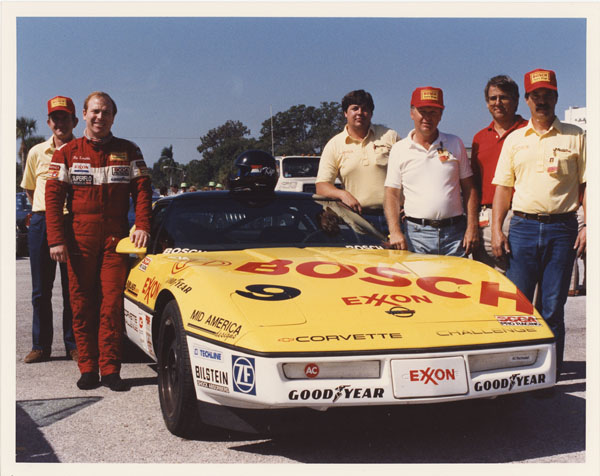
In 1988, fifty-six Challenge cars were built, and fifty were converted. Then in 1989, sixty Challenge cars were built, and twenty-nine were converted. In total, there were one-hundred-sixteen Challenge cars built and seventy-nine were converted. Pratt and Miller are only required to build ten C8 Z06 GT3.R cars for homologation. Yes, the Z06 GT3.R cars are totally scienced-out, but unlike the Corvette Challenge cars can not be registered for the street.
The Corvette story has been on a long and winding road for the last seventy years, with racing totally engineered into its sports car DNA. – Scott


